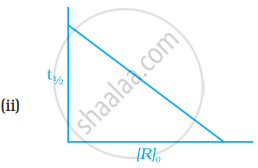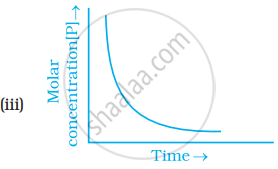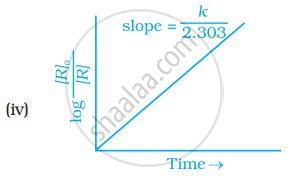Advertisements
Advertisements
प्रश्न
In a pseudo first order hydrolysis of ester in water, the following results were obtained:
| t/s | 0 | 30 | 60 | 90 |
| [A]/mol L−1 | 0.55 | 0.31 | 0.17 | 0.085 |
Calculate the average rate of reaction between the time interval 30 to 60 seconds.
उत्तर
Average rate of reaction between the time interval, 30 to 60 seconds = `("C"_2 - "C"_1)/("t"_2 - "t"_1)`
= `(0.17 - 0.31)/(60 - 30)`
= `0.14/30`
= 4.67 × 10−3 mol L−1 s−1
APPEARS IN
संबंधित प्रश्न
Sucrose decomposes in acid solution into glucose and fructose according to the first order rate law with `"t"_(1/2)`= 3 hours. What fraction of the sample of sucrose remains after 8 hours?
Time required to decompose SO2Cl2 to half of its initial amount is 60 minutes. If the decomposition is a first order reaction, calculate the rate constant of the reaction.
For the decomposition of azoisopropane to hexane and nitrogen at 543 K, the following data are obtained.
| t (sec) | P(mm of Hg) |
| 0 | 35.0 |
| 360 | 54.0 |
| 720 | 63.0 |
Calculate the rate constant.
Following data are obtained for reaction :
N2O5 → 2NO2 + 1/2O2
| t/s | 0 | 300 | 600 |
| [N2O5]/mol L–1 | 1.6 × 10-2 | 0.8 × 10–2 | 0.4 × 10–2 |
1) Show that it follows first order reaction.
2) Calculate the half-life.
(Given log 2 = 0.3010, log 4 = 0.6021)
Which of the following graphs is correct for a first order reaction?




State a condition under which a bimolecular reaction is kinetically first order reaction.
With the help of an example explain what is meant by pseudo first order reaction.
The rate constant of a first order reaction is 6.9 × 10–3s–1. How much time will it take to reduce the initial concentration to its 1/8th value?
In a first order reaction the concentration of reactants decreases from 400mol L-1 to 25 mol L-1 in 200 seconds. The rate constant for the reaction is ______.
The decomposition of formic acid on gold surface follows first-order kinetics. If the rate constant at 300 K is 1.0 × 10−3 s−1 and the activation energy Ea = 11.488 kJ mol−1, the rate constant at 200 K is ______ × 10−5 s−1. (Round off to the Nearest Integer)
(Given R = 8.314 J mol−1 K−1)
A definite volume of H2O2 undergoing spontaneous decomposition required 22.8 c.c. of standard permanganate solution for titration. After 10 and 20 minutes respectively the volumes of permanganate required were 13.8 and 8.25 c.c. The time required for the decomposition to be half completed is ______ min.
The reaction \[\ce{SO2Cl2(g) -> SO2(g) + Cl2(g)}\] is a first-order gas reaction with k = 2.2 × 10−5 sec−1 at 320°C. The percentage of SO2Cl2 is decomposed on heating this gas for 90 min, is ______%.
For a first order reaction, the ratio of the time for 75% completion of a reaction to the time for 50% completion is ______. (Integer answer)
The slope in the plot of ln[R] vs. time for a first order reaction is ______.
How will you represent first order reactions graphically?
Slove: \[\ce{2NOBr -> 2NO_{2(g)} + Br_{2(g)}}\]
For the above reaction, the rate law is rate = k[NOBr]2. If the rate of reaction is 6.5 × 10−6 mol L−1 s−1 at 2 × 10−3 mol L−1 concentration of NOBr, calculate the rate constant k for the reaction.
Write the equation for integrated rate law for a first order reaction.
